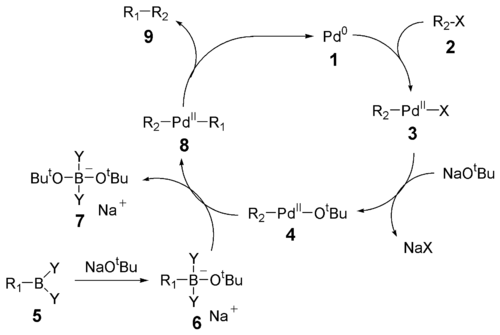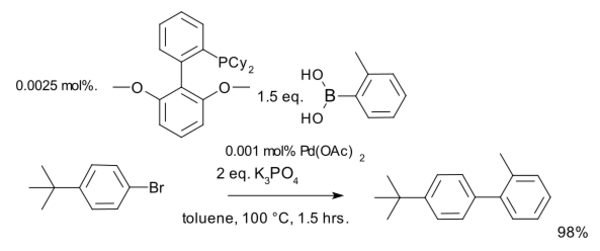تفاعل سوزوكي
تفاعل سوزوكي Suzuki reaction هو تفاعل عضوي لحمض أريل- أو ڤاينيل-البورونيك مع هاليد الأريل أو الڤاينيل محفوزاً بواسطة معقد الپالديوم(0).[1][2] ويستخدم على نطاق واسع لتخليق عديدات الاولفينات، والستايرينات، و ثنائيات الفنيل المستبدَلة، وقد تم مده ليضم بروميدات الألكيل [3]. Several reviews have been published.[4][5][6]
ويعمل التفاعل أيضاً مع الهاليدات الكاذبة، مثل triflates (OTf), بدلاً من الهاليدات، وأيضاً مع إسترات البورون بدلاً من الأحماض البورونية.
- تفاعلية نسبية: R2-I > R2-OTf > R2-Br >> R2-Cl
نشره لأول مرة عام 1979 أكيرا سوزوكي، the Suzuki reaction couples boronic acids (containing an organic part) to halides. The reaction relies on a پلاديوم catalyst such as tetrakis(triphenylphosphine)palladium(0) to effect part of the transformation. محفز البلاديوم (الذي هو في الواقع سابق-للتحفيز) هو رباعي الاحداثيات، وعادة ما يتضمن مجموعات داعمة للفوسفين.
In many publications this reaction also goes by the name Suzuki-Miyaura reaction. It is also often referred to as "Suzuki Coupling" (2010 Nobel prize).
. . . . . . . . . . . . . . . . . . . . . . . . . . . . . . . . . . . . . . . . . . . . . . . . . . . . . . . . . . . . . . . . . . . . . . . . . . . . . . . . . . . . . . . . . . . . . . . . . . . . . . . . . . . . . . . . . . . . . . . . . . . . . . . . . . . . . . . . . . . . . . . . . . . . . . . . . . . . . . . . . . . . . . . .
آلية التفاعل
آلية تفاعل سوزوكي is best viewed from the perspective of the palladium catalyst. The first step is the oxidative addition of palladium to the halide 2 to form the organo-palladium species 3. Reaction with base gives intermediate 4, which via transmetalation[7] with the boron-ate complex 6 forms the organopalladium species 8. Reductive elimination of the desired product 9 restores the original palladium catalyst 1.
اضافة تأكسدية
Oxidative addition proceeds with retention of الكيمياء الفراغية with vinyl halides, while giving inversion of stereochemistry with allylic and benzylic halides.[8] The oxidative addition initially forms the cis-palladium complex, which rapidly isomerizes to the trans-complex.[9]
استبعاد اختزالي
انظر أيضاً
- تفاعل هك
- Hiyama coupling
- Kumada coupling
- اقتران نگيشي
- Petasis reaction
- Stille reaction
- Sonogashira coupling
الهامش
- ^ Miyaura, N. et al. Tetrahedron Lett. 1979, 3437.
- ^ Miyaura, N.; Suzuki, A. Chem. Commun. 1979, 866.
- ^ http://pubs.acs.org/cgi-bin/abstract.cgi/jacsat/2002/124/i46/abs/ja0283899.html
- ^ Suzuki, A. Pure Appl. Chem. 1991, 63, 419-422. (Review)
- ^ Miyaura, N.; Suzuki, A. Chem. Rev. 1995, 95, 2457-2483. (Review, doi:10.1021/cr00039a007)
- ^ Suzuki, A. J. Organometallic Chem. 1999, 576, 147–168. (Review)
- ^ Matos, K.; Soderquist, J. A. J. Org. Chem. 1998, 63, 461–470. (doi:10.1021/jo971681s)
- ^ Stille, J. K.; Lau, K. S. Y. Acc. Chem. Res. 1977, 10, 434–442. (doi:10.1021/ar50120a002)
- ^ Casado, A. L.; Espinet, P. Organometallics 1998, 17, 954–959.
وصلات خارجية
- Suzuki coupling
- Microwave Suzuki coupling: synthetic protocols from organic-reaction.com


